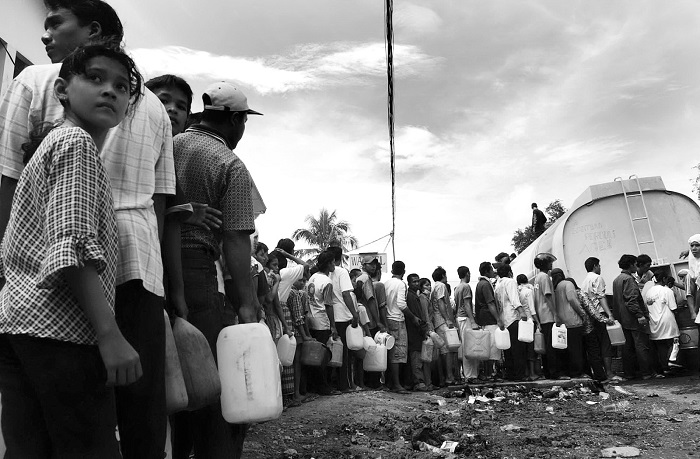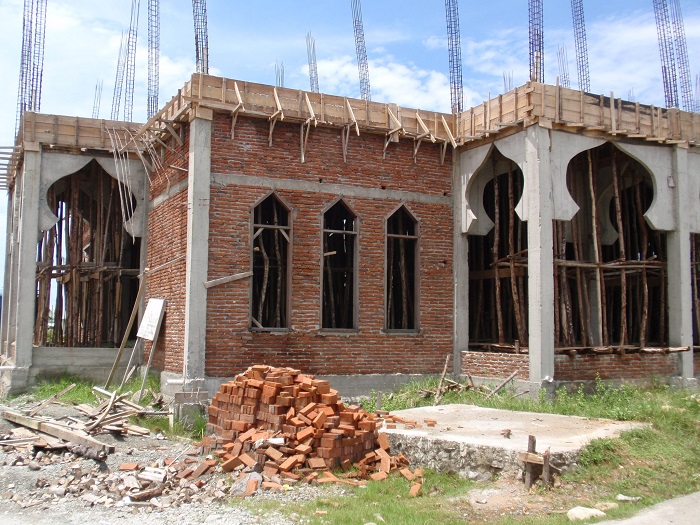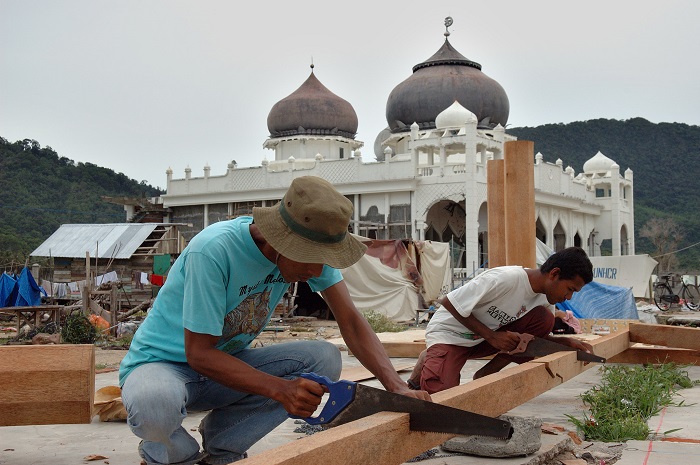David Kloos and Annemarie Samuels
‘At first, it was cloudy,’ Irma said when recalling the morning of 26 December 2004. ‘Then the earthquake came. A little bit at first. Then stronger, then very strong.’ Not long after, people called out that the water was rising. Neighbours started running. Motorcycles collided. The massive tidal wave that followed – and came to be known as the Indian Ocean tsunami – caused an estimated 170,000 deaths in the province of Aceh alone.
In the years that followed, survivors rebuilt their houses and recovered social networks. Many of them moved back to their original neighbourhoods. They often did so with fear: a deeply embodied vulnerability that mended little by little, but that could also break through the surface of recovery at any time, for instance when another earthquake happened, when crowds gathered in the streets, or even when the sound of an airplane brought back the memory of the devastating waves. For Irma, a mother of two school children who returned to her inner-city neighbourhood two years after the disaster, the tiniest change in the environment – sudden winds, contracting clouds – scared her, and even made her keep her children home. She declares, ‘If it is God’s will that we die, we die.’ And yet, she says, ‘If there is a tsunami again, we will run!’.
In Aceh, a predominantly Islamic province, where a local formulation of syariah law was implemented in the early 2000s, the fragility of life is often expressed in a religious idiom. This means, at the same time, that a focus on this idiom offers a crucial entry point for analysing how people understand the vulnerability of their bodies, families and livelihoods. In Aceh and beyond, knowledge of the religious narratives through which people make sense of disaster and respond to this deeply embodied sense of vulnerability and fragility, is mandatory if projects on disaster recovery and risk reduction are to succeed.
Storm
In 2010, five years after the event, the memory of the tsunami still lay as a blanket over affected communities. People were traumatised, they said. This became clear when the weather was rough. Twenty-seven July was a stormy day. It started early in the afternoon with fierce gusts of wind. Then, all of a sudden, chaos reigned. Sheets of corrugated iron, ripped off houses, were blown through the streets. A group of men braved the wind to help another whose mobile food cart had crashed into a deep gutter. Other people rushed home through torrential rain.

In one house, Yunita’s family and a couple of neighbours huddled together. Yunita was scared, she said. The storm brought back memories of the tsunami, including vivid images of a day spent on a rooftop waiting for help and thoughts of loved ones lost. Yunita’s father and two of her brothers were killed that day. ‘Before the tsunami there were also storms. But it was different,’ she said. ‘There were many trees and big houses then. The buildings were closer together.’ In the reconstructed neighbourhood, consisting almost entirely of rumah bantuan – small, basic, more or less identical ‘relief houses’ like Yunita’s – they were left exposed.
Such expressions of fear and vulnerability were intertwined with religious talk. As they sat there together in the house, waiting and hoping that their roof would hold, Yunita wondered out loud what ordeal, what kind of hikmah (divine wisdom or underlying reason) had caused the storm. Her sister Ani responded that it was just like the tsunami: a warning. Then she became more specific. ‘It is this kampung (neighbourhood). We are too close to the beach, too close to Ulee Lhee.’ She was referring to a place nearby known for families as well as young, unmarried couples enjoying themselves on the weekend. ‘This kampung attracts sin.’ They should have a dayah (religious school) in the neighbourhood, she thought, to deter bad behaviour.
Ani’s words reflected a common discourse related to the tsunami. It was an expression of the idea that the tsunami must have had some kind of deeper purpose. Some people said that the disaster was the ultimate measure taken by God to end the violent conflict between the Indonesian military and Acehnese separatists that had plagued the province since the 1970s. Others said that the Acehnese had been hit the hardest by the tsunami not in spite of, but because of their piety. The Acehnese had forgotten, some said, to be fearful of God. The disaster was meant to turn their attention back to Him, while the innocent people who paid for this with their deaths were granted direct entry to heaven. During the tsunami, many thought that the end of the world, or kiamat, had come. When the water receded, they realised it was not. However, many said, the disaster had been a sign of the approaching kiamat, urging those surviving the waves to increase the Islamic piety in themselves and in Acehnese society.
Religious idioms of vulnerability
Yunita and her sister were not, however, having a theological conversation. It was, Ani admitted, speculation, for no one knows the true intentions of God. They were an ordinary family. Moderately devout. Not particularly knowledgeable. Yunita relished edifying stories of prophets. Religious norms were communicated to her children with the help of comic books depicting graphic and gruelling scenes of hell. But most of the time they talked about other things. Money, food, work.

To a large extent, the religious idiom connected to the tsunami served a broader commentary on a place that seemed to have lost all semblance with what it once was. In another conversation, several months earlier, Yunita had talked about the first weeks and months after their return from the emergency barracks. The house was built. Aside from that, there was nothing. Few people had returned. The streets had neither asphalt nor lighting. It was like a ghost town. ‘We would go inside in the evening and not come out until the next morning.’ Step by step the neighbourhood was made liveable again. But building it again the way it was would never happen. A staggering three quarters of the original inhabitants had lost their lives. Reconstruction, moreover, was coupled to the fast and unavoidable social changes of post-conflict, post-disaster society. ‘I don’t know who lives here,’ Yunita’s mother said. ‘They are not from here. They are newcomers. Young people. Students looking for a cheap ‘kos’ to rent. They live alone or together. Girls as well. It is like inviting the Devil!’ Asked whether her own generation was raised differently, she said: ‘We were. But of course, we didn’t listen either.’
Intertwined with such efforts to grasp tremendous social changes, religious idiom and practice helped people to respond to their personal losses and processes of grieving. They considered the tsunami fate and said, like Irma in the inner-city neighbourhood, that death would come at one’s destined time wherever one is. ‘We still have trauma,’ many said in the years after the disaster. They responded to anxiety and sadness by practicing virtues of ikhlas (sincerity) and pasrah (surrender), by trying to accept fate and be patient, and they did so through prayer, chanting and recitation of the Qur’an. When the tsunami waves washed over Aceh, people collectively prayed and chanted on rooftops. Now, they said that prayer and thinking of God helped to ease their racing hearts when dark clouds and heavy rains, storms and earthquakes incited embodied memories of the tsunami.
Religion and disaster response
The presence of religious idioms in people’s responses to vulnerability and misfortune is not unique to Aceh, or to Indonesia. Yet the scale of the tsunami coupled with the historically deeply ingrained presence of religion in Acehnese everyday life has magnified religious discourses on misfortune, not only in the immediate aftermath of disaster, but continuing over the past 15 years. The case of Aceh thereby offers exceptional insights into religious idioms of disaster. These insights may help to better understand socially shared experiences of vulnerability in post-disaster settings in Indonesia and beyond.
From a secular perspective, the belief that natural disaster is a matter of fate may seem like a problem, as fatalism may be thought to correspond with a lack of enthusiasm for reducing vulnerability to disaster. But as both of us noticed during our time in Aceh, applying the concept of fate almost never means inaction. Quite to the contrary, it often comes with equally religiously inspired notions of collective responsibility, perseverance and self-betterment. Individuals and institutions engaged in programs of disaster response would be wise, we feel, to take such notions seriously and consider the potential asset they entail.
David Kloos (kloos@kitlv.nl) is a researcher at the Royal Netherlands Institute of Southeast Asian and Caribbean Studies (KITLV) at Leiden University.
Annemarie Samuels ( a.samuels@fsw.leidenuniv.nl ) is assistant professor of Cultural Anthropology and Development Sociology at Leiden University.
View Mukthar's Story, a short documentary on the aftermath of the Aceh tsunami.
